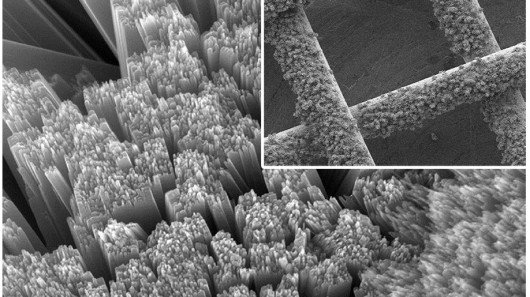
Electron microscope images of the nanometer-sized rods of titanium dioxide that cover the surface of a piece of titanium gauze, allowing air to enter the battery to recharge it while also gathering light to generate electricity (Image: Yiying Wu, Ohio State University)
Researchers at Ohio State University (OSU) have created a dye-sensitized solar cell that stores its own power by "breathing" air to decompose and re-form lithium peroxide. Its creators believe the device, which effectively combines a battery and a solar cell in one, could reduce renewable energy costs by 25 percent.
"The state of the art is to use a solar panel to capture the light, and then use a cheap battery to store the energy," explains OSU professor Yiying Wu. "We've integrated both functions into one device. Any time you can do that, you reduce cost."
This new design uses three electrodes, as opposed to the usual four. At the bottom lies a lithium plate, upon which lies a layer of electrolyte, a thin sheet of porous carbon and then another layer of electrolyte. At the top, a permeable titanium gauze mesh houses a dye-sensitive titanium dioxide photoelectrode, which looks rather like blades of grass at the 1 μm scale and generates triiodide ions under illumination. These ions then spread to the oxygen electrode surface via an iodide "shuttle," where they oxidize into lithium peroxide.
Electrons in the connected battery chemically decompose the lithium peroxide into lithium ions and oxygen, with the oxygen released into the air and lithium ions stored as lithium metal. When the battery discharges, it pulls oxygen from the surrounding environment and consumes it to re-form lithium peroxide – after which the cycle can repeat again.
The mesh is coated with a red dye called ruthenium compound to tune the wavelength of light it captures. This dye absorbs light and releases electrons, creating an electric current as new electrons are drawn from the iodide solution to replace them. Unfortunately, the dye runs out after just eight hours of charging and discharging, which is too short of a lifetime for a cost-effective rechargeable solar cell.
The researchers have done preliminary tests with a hematite (rust) photoelectrode to replace the dye-sensitized titanium oxide, with that seemingly offering comparable efficiency and "remarkably better" stability that may put its lifetime in the same ballpark as rechargeable batteries already on the market.
If they can settle on a material that gets similar efficiency (almost 100 percent of electrons retained, compared to around 80 percent in typical cells) to this titanium oxide version, while also lasting a number of years, the OSU researchers' invention could have huge repercussions in renewable energy. Broader uptake of renewables is currently limited by the high ratio of cost to energy generated and much of the cost comes from grid energy storage that loses more than 25 percent of the electricity coming in.
The US Department of Energy is funding further research, while OSU will license the solar battery to industry and seek to improve its performance.
A paper describing the research was published in the journal Nature Communications.
Source: Ohio State University
copyright © Gizmag 2003 - 2014